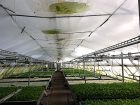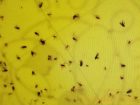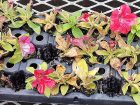
Features
Crop Culture
Inputs
BEDDING PLANTS: Starting Off on the Right Foot
The key issues are not only related to nutrient deficiencies and toxicities, but also to climate control in the greenhouses.
June 7, 2017 By Dr. Mohyuddin Mirza
July 2017 – Growing bedding plants is always a challenge in the sense that over hundreds of varieties and cultivars are grown, nurtured and then sold or marketed to clients or customers.
Although we have categorized plants as being high nitrogen users or medium or low nutrient users, deficiencies are still common. This is because bedding plants, like other plants, need 16 “nutrients” to sustain themselves. If growers are not aware of that, then there is the potential for deficiencies or toxicities. That can render plants unsaleable especially if these problems occur right around early May. It is like saying, “the customers are ready but the plants are not ready to leave the greenhouse.”
The key issues are not only related to nutrient deficiencies and toxicities, but also to climate control in the greenhouses. Many bedding plant growers are seasonal in nature and greenhouses are not up to par with vegetable operations. Bedding plants are started in late February or early March and growers try to save heat as much as possible. Look at the following pictures (Fig. 1 and Fig. 2).
Many growers install a piece of three-mil poly under the greenhouse roof during winter and spring to save heat. This is probably the cheapest method to conserve energy. What happens is that the warm air from the greenhouse is blocked from rising and thus does not come in contact with the plastic on the roof. These plastic films screens are not tight, so warm, moist air escapes and gets in between the roof and the film and condenses. The puddles of condense water are seen in the middle (Fig. 1 and Fig. 2). The puddles must have been forming for several days because algae is growing in them. These puddles pull the plastic down and thus more warm air escapes defeating the original purpose of these plastic films.
Fig. 2 shows how the algae can grow on side walls, indicating a lot of condensation is occurring and staying on the plastic … even cutting down on light.
How does such a climate affect bedding plant? Fungus gnats and shore flies will be in abundance. Although they are considered more of a nuisance, they can transmit fungi, such as pythium, which causes damping off.
There is always an association with high humidity, water puddles and fungus gnats. Also remove old sticky traps especially from sales area (Fig. 3). They don’t look good to customers, especially children accompanying their parents.
Nutritional deficiencies: Nutritional deficiencies are seen in bedding plants every year. Fig. 4 shows multiple issues with petunias. The roots did not develop properly and the plants have lost their ability to absorb nutrients. One can see tip burn due to transpiration demand; lower leaves turning yellow due to nitrogen deficiency; and a purplish tinge indicating not enough phosphorus is being taken up. The result was that plant turned generative and started producing flowers
Fig. 5 shows a serious calcium deficiency in these geraniums. I find that calcium is the most neglected element with bedding plant growers.
When fertilizers containing nitrogen, phosphate and potash are sold, there is a mention of “complete” on the label. “Complete” means that according to the Fertilizer Act they have reported what is needed for labelling purposes. Calcium is generally not added into such formulations and calcium from water is not adequate to supply the needs of the plant. Some calcium is available from the lime added to counter the pH of peat moss but generally it “kicks” in two to three weeks after the growing medium is wetted and root activity starts.
What’s most common is iron deficiency in petunias (Fig. 6), calibrachoa and a few other iron inefficient plants. It is a pH related issue, more alkaline, and it becomes serious if it is not corrected by the time customers arrive. I have written in Greenhouse Canada several times. Check the March 2014 issue (the digital edition is on our website) for information and decision-making tools to manage pH. My recommendation is to correct pH as a priority rather than using iron foliar sprays.
Fig. 7 is another example of a hanging basket ready for sale, however the grower did not pay attention to the pH incompatibility of the petunias and verbenas. Petunias are “iron inefficient” plants and show deficiency when the pH starts going over 6.4, while verbenas are iron efficient plants and don’t show the deficiency. It is difficult to correct the problem at this stage.
It is important to understand the impact of pH in bedding plants production. Many growers get frustrated with their pH meters and stop using them. It’s true that pH meters require constant maintenance and electrodes are expensive to replace and this becomes a source of frustration. Continue to upgrade your knowledge about pH and I am sure great crops can be grown and marketed.
Dr. Mohyuddin Mirza is an industry consultant, drmirzaconsultants@gmail.com.
Print this page






